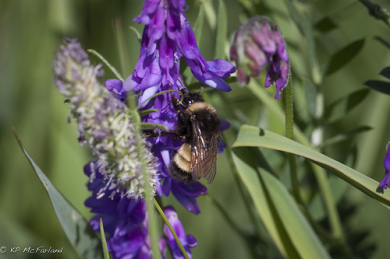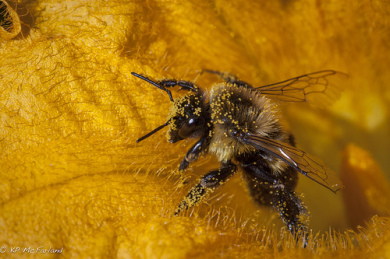Unprecedented search by VCE reveals four species either extinct or declining
More than one-quarter of Vermont’s bumble bee species, which are vital crop pollinators, have either vanished or are in serious decline, according to a new investigation from the Vermont Center for Ecostudies (VCE).
After conducting the most extensive search ever for bees across Vermont, VCE has concluded that three of the state’s 15 bumble bee species appear to have gone extinct and one more may not be far behind.
“We’re losing bumble bees even before we fully understand their benefits to our economy and well-being,” said Kent McFarland, senior conservation biologist at VCE.
Wild bees pollinate wildflowers and most crops in Vermont, including blueberries, tomatoes, squash and one of the state’s essential commodities: apples. Harmful parasites accidentally imported from Europe and a class of pesticides toxic to bees most likely account for the bumble bee declines.
From spring through fall of 2012 and 2013, VCE biologists and a corps of trained “citizen scientists” searched more than 1,500 locations across the state, amassing a database exceeding 10,000 individual encounters with bumble bees. Not once did they find rusty-patched bumble bee (Bombus affinis), which was fairly common in Vermont until the 1990s.
“This investigation confirms our fear that rusty-patched bumble bee is almost certainly extinct in Vermont and may never be back,” said McFarland. “We hardly knew it – and now it’s gone.”
Biologists across the continent are sounding alarms about bumble bee declines – a concern distinct from (but perhaps related to) the widespread collapse of honeybee colonies. VCE’s on-the-ground investigation, arguably the most extensive undertaken in any state, reveals that at least three other bumble bee species warrant concern:
- Ashton cuckoo bumble bee (Bombus ashtoni) infiltrates colonies of rusty-patched and yellow-banded bumble bees, enslaves the workers and uses them to feed its young. With the yellow-banded bumble bee severely depleted and the rusty-patched bumble bees now gone, so goes the invader.
- American bumble bee (Bombus pensylvanicus), once a common bumble bee in the Champlain Valley, has not been found since a University of Vermont student’s unwitting discovery in 2000.
- Yellow-banded bumble bee (Bombus terricola) had been feared to be on the brink of extinction in Vermont, but new encounters with this bumble bee during the VCE survey suggest it might be managing to survive some of the threats.
VCE continues to examine its data to determine if additional bumble bee species warrant attention. The bumble bee field work – the Vermont Bumble Bee Survey – will continue.
“Our next step is to move from investigation toward solutions,” said McFarland. “But those solutions will take hard work and partnerships among federal and state agencies and conservation research groups like ours.”
Trouble for bumble bees may have hitchhiked to the United States from Europe. To increase crop production, especially in greenhouse-grown tomatoes, farmers release common bumble bees into their greenhouses. Yet many of these native bee colonies were formerly raised in Europe, where they were infected with an intestinal parasite. When the infected bees were returned to North America for use in agriculture, probably in the 1990s, the European parasite spread among otherwise defenseless American bees.
Another culprit could be common pesticides, including a group known as neonicotinoids. “Neonicotinoid pesticides are particularly dangerous to bees because plants absorb them through the roots, rendering all plant parts toxic to insects,” said Leif Richardson, an entomologist at Dartmouth College and co-author of the upcoming Guide to Bumble Bees of North America. “This includes pollen and nectar, essential components of the bee diet.”
Habitat loss and urbanization are also taking their toll on pollinator populations of all kinds, bees included.
“Wild bees perform the majority of all pollination on Vermont farms, whether or not the managed European honey bee is present,” said Richardson. “As an ecosystem service, pollination is worth millions annually. But we don’t know how the loss of native bee species will affect our food supply or overall environmental health.”
Comments (7)
Pingbacks (2)
-
[…] Bumble Bees in Peril […]
-
[…] Recently, VCE biologist Kent McFarland was on Across the Fence, produced by the University of Vermont Extension. They have been on-air on WCAX-TV since 1955, the longest-running, locally-produced television program in the US. In this episode you can check out a UVM class that is designing landscapes for pollinators with an emphasis on native plants and then listen to Kent talk about the preliminary results of the 2-year Vermont Bumble Bee Survey and learn about the state of our bumble bees. […]



Reblogged this on One Square Meter.
I was surprised to read that bumble bees on in peril because I had loads of them in my yard this year. I don’ t, of course, know the different varities. I was also surprised one day when I was in my meadow and found I was surrounded by honey bees, which I hadn’t seen in quite awhile. Would love to participate i. Your bumble bee survey.
Hi Irene,
Thanks for the note. Indeed, there are still several species that are quite common. We formerly had about 17 species in Vermont and out of those there are about 100 different color combinations among the species so it is hard to tell all the species. But for sure, we have had a drastic loss of at least of quarter of the species. Next year we will be kicking off more work with a neat online web page and database, so please stay in touch with us next spring! Enjoy the winter. Kent
According to this 1941 review by the USDA, “The Dependence of Agriculture on the Beekeeping Industry—a Review” (http://archive.org/stream/deperi00unit/deperi00unit_djvu.txt), declines on bumble bee populations were already noticeable then. Please, I would like to read your comments.
I am sure there were local declines then as this old report you found suggests, and at other times with various species of Bombus given the land use changes that occurred in various regions. What we and others have documented with several Bombus species is a more regionwide or rangewide decline of certain species, much of it since the late 1990s. Most science is now pointing to introduced parasites perhaps in conjunction with habitat loss, pesticides and changing climate. You can find more about this here: http://www.ncbi.nlm.nih.gov/pmc/articles/PMC3021065/ as well as in several other papers.
Thanks. There must have been massive population losses, rather than local declines, as intensive farming grew during the last hundred years. I look at Google Earth and see areas in which 99% of the land is taken by monocrop fields. If there were any flowers and native bees originally, they are practically all gone. The paper you cited says that the researchers chose flower patches to do their collections. They also mention parks and preserves, not farmland. If there were hundreds of flower patches before and there are only one or two now, that study doesn’t show the magnitude of the loss. This has happened in countless places turned into large farm fields.
I wonder if there is some way of designing research that takes into account land use now and a hundred years ago, and calculates how much habitat has been lost to intensive agriculture. Then extrapolate from there to get some rough numbers of the wild bee populations that existed before the land was so drastically modified.
I am sure there were in regions. This recent report from NSF on coneflower is case in point for midwest, http://www.nsf.gov/discoveries/disc_summ.jsp?cntn_id=130338&WT.mc_id=USNSF_57&WT.mc_ev=click. But, I am talking about Vermont. We had a sheep rush in the late 1800s that created massive pasture, then we slowly went back to forest and are now back at over 80% forested. It surely affected many species of bees. We just don’t have much data. We do have reasonably data for Bombus from the 1960s into 2000s from student collections. Not perfect data, but at least something to go on. So our two year survey across VT over the last two years compared to those data are quite alarming for recent population declines and in some cases outright disappearance.
There is another recent paper that looked at long term changes using a massive dataset of historic collections, http://www.pnas.org/content/early/2013/02/27/1218503110.abstract. This paper is quite interesting, especially if you dig into the supplementary information too.